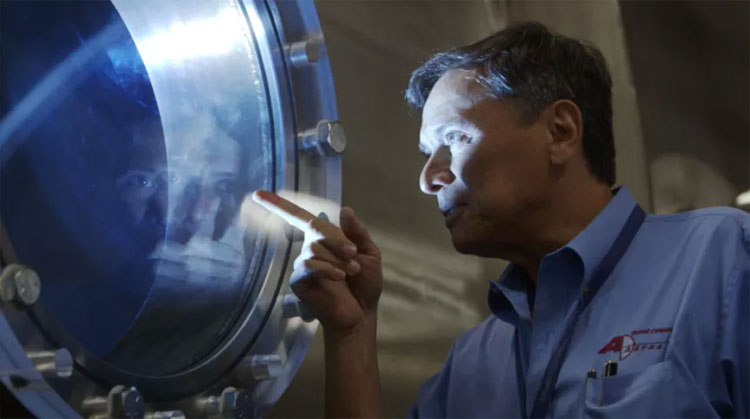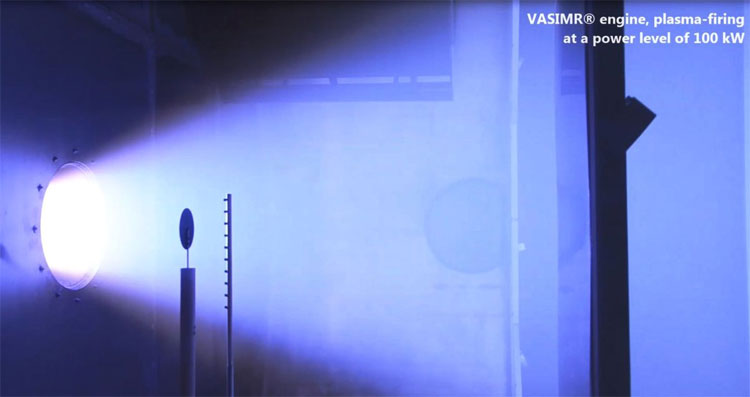66-year-old astronaut's plasma rocket - NASA bet on upcoming fruit picking (Part 1)
The breakthrough in this technology industry caught NASA's attention two years ago and now, what is the fate of it?
Mr. Franklin Chang-Díaz slowly walked on the long steps to reach a large silver vacuum chamber of the size of a large truck. Looking inward, a bluish-violet light played continuously like a long-time flashlight, which gave off a pleasant look but many boring parts, Mr. Chang-Díaz admitted. "But that beam of light is 3.5 million degrees Celsius. If you get stuck in it, maybe that happens will be very bad."

Mr. Franklin Chang-Díaz.
In fact, that faint violet-blue light did not leave a strong impression, but the engine used to create it in that vacuum was a revolutionary technology. There are two reasons to explain that:
First of all, unlike other rocket-fueled rocket engines, its predecessors, this engine uses very little energy. Second, this motive will one day generate enough speed to bring people to explore the distant horizons of the Universe or in the immediate future, which is every corner of the Solar System.
"Getting people to explore" has been the promise of Mr. Chang-Díaz since he started researching and manufacturing this VASIMR plasma rocket engine. From a theoretical physics perspective, this engine is still very logical: create plasma, excite it and push it out at a high speed. But in fact, our technique has not reached that breakthrough.
To make the magic of VASIMR, we have to control plasma and its special thermal properties, maintain a successful combustion state for a long enough time, the time a rocket requires in a journey through space. The difficulties made many people question the potential motives.

"Getting people to explore" was Mr. Chang-Díaz's promise from the day he started his research.
No matter who says it in a slant way, no matter how much suspicion one puts, they cannot deny that Mr. Chang-Díaz is a great hardworking person with a talented mind. When he first came from Costa Rica and entered the United States in 1969 to complete the high school program, he could barely speak any English.
But then, over the years of great efforts, he earned his Ph.D. from the Massachusetts Institute of Technology and later, as an astronaut, Chang-Díaz flew a total of seven external missions. space, equaling the record of fellow colleague Jerry Ross with the most space missions ever.
From the early days at Johnson Space Center, when he was installed on the Internet to work with Boston's plasma physics lab data, Chang-Díaz grew a dream to use his knowledge. already know about science for future development.
Gradually, with every step forward, he developed a hypothesis about a plasma rocket system and began installing the prototype. During that breakthrough, scientific critics still whispered that Mr. Chang-Díaz is nurturing an utopian dream.

Mr. Chang-Díaz with the mission of the universe in 2002, contributed to the installation of the ISS space station.
But now things are different. His project has become part of the next generation development program of NASA's rocket system, Chang-Díaz's Ad Astra has been approved by a Space Agency. 3-year term, worth 9 million USD in 2015.
This is his chance to prove that his plasma rocket is not a fictional product. As usual, to prove something that many people think is impossible, a person will have to go through extremely difficult stages: Ad Astra must maintain the plasma rocket that works continuously for 100 hours, with 100 kilowatts of energy and they have deadlines for success next year, 2018.
This February, they were half way through the contract, and they were able to succeed somewhat compared to the final goal, when the VASIMR engine was running at 100 kW within 10 seconds and 50 kW within 1 minute. The road is still long.
A rocket in the dream

VASIMR motor is fed into vacuum chamber for testing.
The rocket engine starts with a rare gas as a fuel for plasma, in this case it is argon . In the first stage, the missiles ionize the amount of argon and turn them into a kind of cold plasma. The motor then delivers the amount of plasma into the second stage - the propulsion stage, through a physical phenomenon called ion cyclotron resonance heating. Basically, boosters use radio frequencies to act on ions, causing them to oscillate back and forth continuously.
The resonant ion creates more energy, they are converted into an extremely hot plasma. The plasma flowed through the drain, the back of the missile, creating a propulsion to send the rocket forward.
Such a design of plasma engines gives us certain advantages over contemporary rocket technology. Perhaps, most notably, unlike missiles that use chemical reactions to function, plasma missiles run on electricity. It doesn't need a huge fuel tank to operate, but only a few large solar panels.

This is where the plasma will be released.
The Sun will be a source of energy for both plasma production as well as stimulating plasma causing thrust, and these two states can be switched together when needed. When the rocket escapes Earth, it needs a large amount of energy to produce plasma.
This process uses a lot of repulsive force, but we need it to create a repulsive force large enough for the rocket to escape from a large gravitational force, such as Earth. When rockets have stabilized their speed in space, energy can be transferred to stimulating plasma to push. This will allow rockets to have two distinct speed types and more reasonable use of energy.
"It's like shifting cars," explained Mr. Chang-Díaz. "The engine will not change. But if you want to go uphill, you need to push more energy into the torque shaft and bring less energy into creating a minute of rotation, you will climb the hill with speed. but it's important that you're climbing the slope, and when you run on the highway, with a flat and straight line, you'll go up the number, obviously you won't go to Mars with the engine to be number one That's the current problem, which is why we run out of fuel when we go to Mars, using an engine that uses chemical reactions to create thrust. "
Another advantage of this type of engine is that the plasma is kept in a separate magnetic field inside the engine, throughout the combustion of the rocket. In theory, this will make the engine still durable after a long operation - this will be extremely useful during our journey through the Solar System.
Solar energy thrust
The concept of using solar energy to push spacecraft through space sounds extremely familiar. That's because five decades ago, both the US and the Soviet Union tested the Hall propulsion engine along with this energy principle and then, the Russians were the first to create a working product. With that technology, electrical energy is used to ionize fuel to create thrust (usually Xenon), allowing the rocket to move forward.

Outside Mr. Chang-Díaz's test chamber.
NASA used Hall boosters for some missions to take the probe into space, most notably the Dawn spacecraft used to explore Vesta and Ceres, the two objects within the asteroid belt. right in this Solar System, between Mars and Jupiter.
The Dawn is equipped with three Hall boosters, powered by 10 kilowatts of electricity generated by the solar battery system, a total of 90 milinewton. That amount of power is quite small compared to a rocket fuel powered engine, with thrust up to 500 newtons. However, Hall propulsion does not take a huge amount of fuel like an old-style engine, it uses fuel slowly and can be burned continuously.
This solar electric propulsion technology can allow us to get smaller engines that require modest amounts of fuel but with a long and continuous use time, it will also produce an equal speed. with popular rocket engines today.
A Hall boosters will create a relatively small repulsive force, but with the ability to combine, many Hall boosters will create a repulsive force large enough to move through the universe. That is what NASA is planning to apply to its Mission of Identifying asteroids with robots - its Asteroid Robotic Redirect Mission (ARRM) . They will bring a solar-powered spacecraft to the universe to collect samples on the surface of an asteroid and return to space near the Moon, waiting for a team of scientists to fly there. and research what is collected. Currently, a number of prototype solar powered boosters have been operating at 40 kW of electricity.

The 13 kW Hall model is tested at the Glenn Research Center, located in Cleveland.
The 40kW figure is almost the upper limit of boosters Hall and NASA is also pleased with that number when planning to use Hall for missions to bring supplies and research tools to Mars, when people have set foot on it. BUT, with this VASIMR technology , 40 kW is the lower limit of its power ability and yet, it still has the potential to become stronger.
In addition to other outstanding features, Mr. Chang-Díaz's missile also generates thrust on a unit of fuel twice as much as a conventional rocket: that means it will use less energy than the Hall but still achieve the same performance. But the most problematic thing is that this new technology has never entered the actual flight test phase, because NASA has invested a lot in developing the Hall boosters, the immediate switch. New technology will be extremely wasteful. That's why after the 3-year contract and a large investment amount in 2015, it is so big.
"NASA has invested a huge amount of money in Hall rocket technology , " said Chang-Díaz. "We are latecomers. But now NASA has paid attention to our technology. They realize that this plasma rocket has good performance and has the potential to achieve even greater power. can bring technology from outside to penetrate NASA ".
- 66-year-old astronaut's plasma rocket - NASA bet on upcoming fruit picking (Part 2)
- What kind of watches do NASA astronauts use?
- Discovered ripe fruit thanks to microwave scanning system
- Use plasma rays to remove bacteria in fruits
- Plasma rockets can send people to Mars
- NASA's new generation spacecraft rocket launcher
- Chorus of plasma waves around the Earth
- The taboo when eating dragon fruit, everyone should know to avoid picking up disease in the body
- What is a plasma rocket and why can we travel interplanetary to it?
- NASA recruited astronauts for Mars exploration campaign
- Australia tested the world's first mango picking robot
- America wants to explore the hidden part of the Moon
 Van Allen's belt and evidence that the Apollo 11 mission to the Moon was myth
Van Allen's belt and evidence that the Apollo 11 mission to the Moon was myth The levels of civilization in the universe (Kardashev scale)
The levels of civilization in the universe (Kardashev scale) Today Mars, the sun and the Earth are aligned
Today Mars, the sun and the Earth are aligned The Amazon owner announced a secret plan to build a space base for thousands of people
The Amazon owner announced a secret plan to build a space base for thousands of people